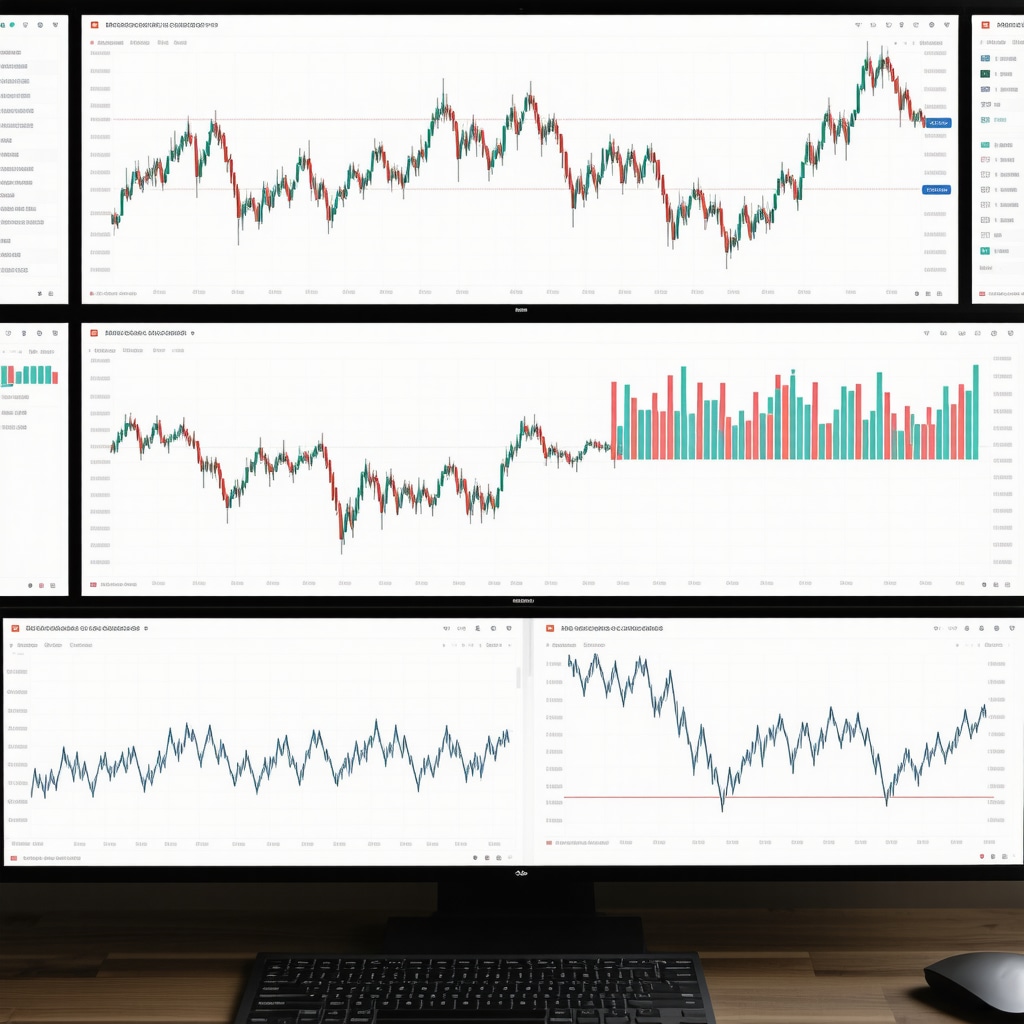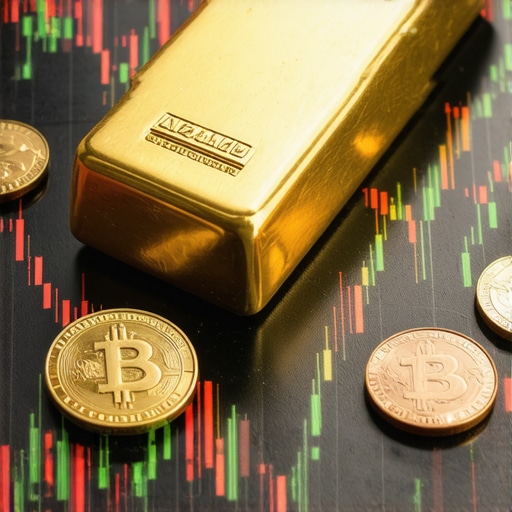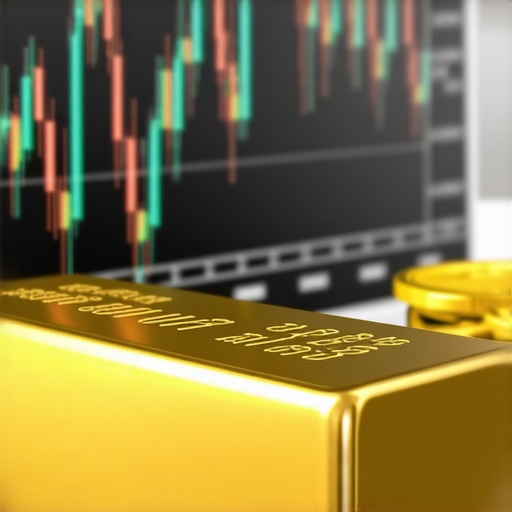Unlocking the Timeless Allure of Gold in Modern Investment Portfolios
Gold has long been revered not just as a symbol of wealth but as a resilient asset that can anchor an investment portfolio through turbulent economic tides. When considering how to build a gold investment portfolio for steady returns, understanding gold’s multifaceted role in wealth preservation and growth is paramount. This guide dives deep into crafting a strategic gold allocation tailored for stability and consistent performance.
Crafting a Balanced Gold Portfolio: Beyond the Glitter
Building a gold investment portfolio is not merely about accumulating physical bars or coins; it encompasses a spectrum of gold-related assets. Allocating investments across physical gold, gold ETFs, and mining stocks can optimize risk-adjusted returns. Physical gold offers tangible security and inflation hedging, while ETFs provide liquidity and ease of diversification. Meanwhile, gold mining equities add growth potential but come with higher volatility.
For instance, seasoned investors may allocate 40% to physical bullion for safety, 40% to gold ETFs for flexibility, and 20% to select mining stocks targeting growth. This nuanced approach balances preservation with opportunistic gains.
What Are the Key Factors Influencing Gold’s Steady Returns?
Gold’s steady returns hinge on several critical factors including global economic uncertainty, inflation trends, central bank policies, and supply-demand dynamics. Economic downturns and inflationary pressures typically increase gold’s appeal as a safe haven asset. According to the World Gold Council, central bank gold purchases have been pivotal in underpinning prices during volatile periods (World Gold Council on Central Bank Gold Purchases).
Moreover, understanding gold’s supply constraints—such as mining output and recycling rates—helps anticipate price movements, enabling investors to time their portfolio adjustments prudently.
Strategic Selection: Choosing Gold Investment Vehicles That Align With Your Goals
Discerning investors must consider the trade-offs of various gold investment vehicles. Physical gold, while offering tangible ownership, requires secure storage and insurance, which can impact net returns. Gold ETFs, conversely, offer ease of trading and instant liquidity but may entail management fees and lack physical backing.
For those seeking indirect exposure, gold mutual funds or futures contracts present alternative avenues, each with unique risk profiles and return potentials. Exploring types of gold investments can illuminate which vehicle aligns best with individual risk tolerance and investment horizon.
Integrating Gold Into a Diversified Portfolio: The Art of Risk Mitigation
Incorporating gold effectively requires recognizing its low correlation with traditional asset classes such as equities and bonds. This characteristic makes it a powerful hedge against market volatility and inflationary shocks. A well-diversified portfolio with calibrated gold exposure—typically between 5% to 15% depending on market conditions and investor profile—can smooth returns and protect capital.
Experienced investors often rebalance gold holdings in response to macroeconomic signals and price trends, a practice supported by insights into gold price trends and market signals for timely adjustments.
Real-World Wisdom: Practical Tips From Gold Investment Veterans
Seasoned gold investors emphasize the importance of sourcing gold from reputable dealers to avoid fraud and ensure authenticity. Secure storage solutions, whether via insured vaults or trusted custodians, are essential to safeguard physical assets.
Furthermore, staying informed on global economic developments, geopolitical tensions, and monetary policies empowers investors to anticipate gold market shifts. Leveraging expert resources and continuous education, as found in authoritative guides like the Investing in Gold for Beginners, equips investors to navigate complexities with confidence.
Are you ready to enhance your investment approach with gold? Share your thoughts or questions below to join a community dedicated to building resilient portfolios through precious metals.
Learning From Experience: Navigating Gold Market Volatility
Reflecting on my own journey investing in gold, I recall times when the market was especially volatile. The key lesson I’ve learned is patience paired with a clear strategy. For example, during periods of geopolitical tension, gold prices often spike, but timing the peak is nearly impossible. Instead, I focus on steady accumulation and periodic portfolio rebalancing, rather than chasing short-term gains.
One practical approach I’ve adopted is setting predefined thresholds for buying or selling based on market signals. This disciplined method helps avoid emotional decisions, which can be costly in the gold market. Additionally, diversifying within gold assets—like mixing physical gold with ETFs and mining stocks—has cushioned my portfolio from unexpected swings.
How Can You Gauge When Gold Is the Right Move?
This question often comes up among fellow investors. To me, the right moment to increase gold exposure usually aligns with rising inflation expectations or economic uncertainties, such as central bank policy shifts or geopolitical risks. Monitoring gold price trends and market signals has been invaluable in this regard.
For instance, watching the actions of central banks, which according to the World Gold Council significantly influence gold prices, provides critical clues. When central banks increase gold reserves, it’s often a signal to consider upping your gold holdings.
Practical Tips for Secure Gold Investment
From my experience, securing your physical gold is just as crucial as selecting the right investment vehicle. I recommend using insured vaults or trusted custodians to protect against theft or loss. When purchasing, always verify the reputation of dealers to avoid counterfeit risks—something I learned the hard way early on.
Moreover, staying informed by engaging with communities and trusted resources, like the Investing in Gold for Beginners guide, helps in making confident decisions and adapting to market shifts.
Have you experienced the ups and downs of investing in gold? What strategies have worked best for you? Share your stories and questions below—I’d love to hear your insights and continue this conversation with fellow enthusiasts.
Decoding Macroeconomic Signals: Leveraging Advanced Analytics for Gold Investment Timing
While traditional indicators like inflation and geopolitical tensions guide gold investors, integrating advanced macroeconomic analytics can elevate portfolio performance. Utilizing econometric models and machine learning algorithms to analyze variables such as real interest rates, currency fluctuations, and commodity cycles offers nuanced insights into gold price trajectories. For example, the inverse relationship between real yields and gold prices is well-documented, but dynamic models capturing temporal shifts provide a tactical edge for timing acquisitions or divestments.
Moreover, sentiment analysis derived from global news feeds and central bank communications can act as early warning signals for abrupt market shifts. These techniques, often employed by institutional investors, empower sophisticated portfolio managers to anticipate volatility and adjust gold allocations proactively rather than reactively.
How Do Central Bank Gold Reserves Influence Global Market Stability and Investor Decisions?
Central bank gold reserves are a cornerstone in assessing macro-financial stability. Their accumulation or liquidation reflects confidence in fiat currencies and can signal shifts in monetary policy. When central banks increase gold holdings, it often indicates a strategic move to hedge against currency depreciation or geopolitical risk. Conversely, selling gold reserves might suggest liquidity needs or confidence in domestic economic conditions.
According to a detailed report by the International Monetary Fund (IMF Working Paper on Gold in Monetary Systems), central banks’ gold policies have a profound impact on global gold prices and the stability of financial markets. Investors who monitor central bank behavior can align their gold investment strategies more effectively, capitalizing on these macro moves.
Harnessing Gold Derivatives: Sophisticated Tools for Risk Management and Leverage
Beyond conventional gold holdings, derivatives such as options, futures, and structured products offer intricate mechanisms for risk mitigation and enhanced returns. Experienced investors and portfolio managers utilize gold futures contracts to hedge exposure or speculate on price movements with defined risk parameters. Options on gold ETFs or futures provide asymmetric risk profiles, allowing for strategic plays on volatility or directional trends without the need for full capital commitment.
However, these instruments require deep market understanding and risk controls to avoid leverage-induced losses. Incorporating derivatives demands rigorous scenario analysis and stress testing within portfolio risk frameworks, ensuring alignment with long-term investment objectives.
Integrating ESG Considerations in Gold Investment: Ethical Sourcing and Sustainability Impact
As Environmental, Social, and Governance (ESG) criteria gain prominence, discerning investors scrutinize the ethical footprint of gold mining operations. The provenance of gold—whether from conflict-free zones, adherence to fair labor practices, and minimal environmental disruption—now factors heavily into investment decisions.
Investment vehicles like ESG-compliant gold ETFs and funds focus on companies demonstrating robust sustainability standards, thereby aligning financial goals with responsible stewardship. This emerging trend not only mitigates reputational risks but also appeals to a growing demographic prioritizing ethical investments.
To explore ESG-focused gold investment options, consulting specialized reports from organizations such as the Responsible Mining Foundation provides critical evaluation metrics and company rankings.
Engage With Expert Gold Investment Insights and Elevate Your Portfolio Strategy
Mastering gold investment in today’s complex financial landscape requires a blend of traditional wisdom and forward-looking analytical tools. By integrating macroeconomic analytics, monitoring central bank gold policies, leveraging derivatives prudently, and embracing ESG principles, investors can build resilient portfolios poised for sustained growth.
Are you ready to deepen your gold investment expertise? Subscribe to our newsletter for exclusive analyses, expert interviews, and advanced strategy guides that keep you ahead in the precious metals market. Your journey to sophisticated gold investment starts here.
Decoding Advanced Macroeconomic Indicators for Proactive Gold Investment Decisions
Elevating gold investment beyond conventional wisdom necessitates a granular understanding of intricate macroeconomic variables. Seasoned investors harness real-time data on real yields, currency volatility, and global monetary policies using cutting-edge econometric models. These analytical frameworks unveil subtle causal relationships and temporal dynamics that traditional metrics often overlook, enabling preemptive portfolio adjustments to capitalize on impending price inflections.
For instance, the dynamic interplay between the US dollar index fluctuations and gold prices can be dissected through vector autoregression models, affording investors foresight into market shifts. Additionally, incorporating sentiment analysis from central bank communications and geopolitical news streams delivers actionable intelligence, detecting early signals of market stress or opportunity.

How Can Advanced Analytics Improve Timing and Risk Management in Gold Investing?
Advanced analytics empower investors to transcend reactive strategies by providing quantitative insights into market regimes and volatility clustering. Through machine learning algorithms trained on historical gold price data alongside macroeconomic indicators, investors can identify non-linear patterns and regime shifts that traditional analysis might miss. This facilitates optimized entry and exit points, enhances hedging strategies, and mitigates downside risks in volatile environments.
Moreover, scenario analysis integrated with stress testing allows portfolio managers to evaluate gold allocations under diverse economic contingencies, ensuring alignment with long-term objectives and risk tolerance. These sophisticated tools transform gold investing from intuition-based to data-driven precision.
Harnessing Gold Derivatives: Sophisticated Instruments to Amplify Returns and Mitigate Exposure
Beyond spot holdings, the strategic deployment of gold derivatives such as futures, options, and swaps offers unparalleled flexibility to tailor risk-return profiles. Institutional investors frequently use gold futures for precise hedging against price fluctuations, while options strategies—including protective puts and covered calls—permit asymmetric risk positioning with defined capital outlays.
Structured products linked to gold further enable bespoke payoff structures aligned with investor convictions on volatility or directional trends. However, mastery of these instruments demands rigorous quantitative acumen, comprehensive risk controls, and continuous market monitoring to prevent leverage-induced pitfalls.
Integrating ESG Metrics: Aligning Ethical Considerations with Gold Investment Excellence
Incorporating ESG criteria into gold investment frameworks transcends compliance, reflecting a paradigm shift toward responsible capital allocation. Investors increasingly scrutinize mining companies’ adherence to environmental stewardship, human rights, and governance best practices—factors that materially influence long-term operational sustainability and reputational risk.
ESG-focused gold funds and ETFs curate portfolios emphasizing conflict-free sourcing, reduced carbon footprints, and robust community engagement. Leveraging detailed evaluations from specialist organizations like the Responsible Mining Foundation equips investors to align financial performance with societal impact, fostering resilience amid evolving regulatory and consumer expectations.
Expert Insights from the International Monetary Fund: Central Banks’ Strategic Gold Holdings and Market Implications
The International Monetary Fund’s comprehensive analysis underscores central banks’ pivotal role in shaping global gold markets through reserve management. As detailed in the IMF Working Paper on Gold in Monetary Systems, shifts in official gold holdings serve as critical barometers of monetary confidence and geopolitical risk appetite.
Investors attuned to these central bank movements can anticipate macroeconomic inflections and adjust gold allocations accordingly, capitalizing on the liquidity and price stability such interventions confer. This strategic awareness enhances portfolio resilience amid global financial uncertainty.
Engage With These Advanced Gold Investment Strategies to Transform Your Portfolio
Embracing the multifaceted dimensions of gold investing—from advanced macroeconomic analytics and derivatives mastery to ESG integration and central bank intelligence—positions you at the forefront of portfolio innovation. Harness these sophisticated insights to optimize risk-adjusted returns and safeguard wealth in an increasingly complex financial landscape.
Ready to elevate your gold investment approach? Subscribe now for exclusive access to in-depth analyses, expert webinars, and cutting-edge strategy guides that empower you to navigate the precious metals market with unmatched confidence and precision.
Frequently Asked Questions (FAQ)
What is the optimal percentage of gold to hold in a diversified investment portfolio?
While individual circumstances vary, financial experts generally recommend allocating between 5% to 15% of a portfolio to gold. This range balances gold’s role as a hedge against inflation and market volatility without overly concentrating risk. The exact allocation depends on factors such as investment horizon, risk tolerance, and prevailing macroeconomic conditions.
How do central bank gold reserves affect gold prices and investor decisions?
Central banks influence gold markets significantly through their reserve management. Increases in gold holdings often signal hedging against currency depreciation or geopolitical risks, which tends to support higher gold prices. Conversely, sales may indicate liquidity needs or confidence in fiat currencies. Monitoring central bank activity provides investors with strategic cues for adjusting gold exposure.
What are the main differences between investing in physical gold, ETFs, and mining stocks?
Physical gold offers tangible ownership and inflation protection but requires secure storage and insurance. Gold ETFs provide liquidity, ease of trading, and diversification benefits but may carry management fees and lack physical backing. Mining stocks offer growth potential tied to company performance but come with higher volatility and operational risks. A balanced portfolio often blends these assets to optimize risk-adjusted returns.
How can advanced macroeconomic analytics improve gold investment timing?
Advanced analytics, including econometric modeling and machine learning, enable investors to decode complex relationships between gold prices and variables like real interest rates, currency fluctuations, and geopolitical sentiment. These tools help anticipate market regime shifts, optimize entry and exit points, and enhance risk management beyond traditional intuition-based methods.
Are gold derivatives suitable for individual investors?
Gold derivatives such as futures and options offer sophisticated strategies for hedging and leveraging gold exposure but require deep understanding of market mechanics and risk controls. They are generally more suitable for experienced investors or institutional portfolio managers due to their complexity and potential for amplified losses if mismanaged.
What role does ESG play in modern gold investing?
ESG considerations have become integral in gold investment, focusing on ethical sourcing, environmental stewardship, and social responsibility. ESG-compliant funds and ETFs prioritize mining companies with transparent and sustainable practices, helping investors align their portfolios with ethical values while mitigating reputational and regulatory risks.
How can investors ensure the authenticity and security of physical gold?
Purchasing from reputable dealers with verifiable track records is critical to avoiding counterfeits. Secure storage options include insured vaults and trusted custodians, which protect against theft or loss. Regular audits and insurance coverage further safeguard physical gold holdings.
When is the best time to increase gold allocation?
Typically, increasing gold exposure is prudent during periods of rising inflation expectations, economic uncertainty, or geopolitical tensions. Monitoring central bank purchases, currency volatility, and macroeconomic indicators can guide timely adjustments to gold allocations.
Can sentiment analysis from news and central bank communications enhance gold investment strategies?
Yes, sentiment analysis provides early signals of market stress or opportunity by tracking shifts in geopolitical developments and monetary policy rhetoric. Integrating these insights with quantitative models helps investors anticipate price movements and adjust portfolios proactively.
What are the risks involved in investing in gold mining stocks?
Gold mining stocks carry risks including operational challenges, regulatory changes, commodity price volatility, and geopolitical factors affecting mining regions. Unlike physical gold, these stocks are subject to company-specific risks that can amplify price swings, necessitating careful due diligence and diversification.
Trusted External Sources
- World Gold Council – Offers comprehensive research on gold demand, supply, and central bank purchase trends, essential for understanding market fundamentals and investor behavior.
- International Monetary Fund (IMF) – Provides authoritative working papers and analyses on gold’s role in the international monetary system and central bank reserve management, informing macroeconomic perspectives.
- Responsible Mining Foundation – Delivers in-depth assessments of ESG practices within the gold mining sector, supporting ethical investment decision-making.
- Bloomberg Commodity Research – Supplies real-time data, advanced analytics, and market intelligence on precious metals, aiding sophisticated investment timing and risk management.
- Financial Times and The Wall Street Journal – Trusted financial publications offering timely news, expert commentary, and geopolitical analysis relevant to gold markets.
Conclusion: Synthesizing Gold Investment Expertise for Resilient Portfolios
Gold remains a cornerstone asset for investors seeking steady returns and portfolio resilience amid economic uncertainty. By embracing a diversified approach—combining physical gold, ETFs, and mining equities—investors can harness gold’s multifaceted benefits. Advanced macroeconomic analytics and sentiment monitoring empower timing precision, while integrating ESG criteria aligns investments with evolving ethical standards. Central bank gold reserve trends serve as vital market barometers, guiding strategic allocation adjustments.
Mastering these complex dimensions transforms gold investing from a reactive endeavor into a proactive, data-driven pursuit that balances growth, risk mitigation, and sustainability.
Engage with this knowledge: share your insights, explore related expert content, and apply these advanced strategies to fortify your investment portfolio with gold’s timeless allure.










